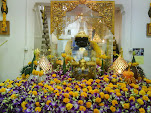Wat Phra Phuttha Bat Ratcha Wora Maha Wihan,Phra Phuttha Bat District, Saraburi Province
This is a Thai Buddhist belief, Lord Buddha's "Left Footprint" was probably discovered in the reign of King Song Tham. The stairways, which were constructed in the era of King Rama I consist of three paths, each of which is decorated with a Naga figure. Each path starts with a five headed naga named "Muchalin." From left to right, the 3 paths are supposed to represent silver, crystal and gold. People believe that a wish for money and gold will be granted if they climb silver and gold stairs respectively, and prestige and other endowments if they ascend the crystal stairs.
Wat Phraputthabat Ratcha Wora Maha Wihan is located in Tambon Khun Khlon, 28 kilometres north of the town, turn left and travel for one km before arriving in Phra Phutthabat district. The historical Lord Buddha's Footprint was found on a stone panel near Suwan Banpot Hill or Satchaphanthakhiri Hill.
Lord Buddha's Footprint measures 21 inches wide, 5 feet long, and 11 inches deep. The footprint was discovered during the reign of King Songtham of Ayutthaya. The footprint had 108 religious aspects, so he commanded a temporary Mondop be built to cover the footprint and it has been refurbished several times. The Mondop is a square building, has a seven-tier castle roof and each tier is covered with green glazed tiles. Each level is decorated with an arch supported by wood, gold and coloured glasses. The external walls are also decorated with gold and coloured glasses in the shapes of mythological gods and lotus top. The pearl inlaid artwork on the Mondop doors represent some of the best craftsmanship in the country. A five-headed Naga, cast in bronze, flanks the stairs. The Mondop is surrounded by bells, which visitors can ring to make merit. The surrounding Ubosot and Vihara were built according to the architectural styles of the Ayutthaya and early Rattanakosin periods.
In the temple compound there is the Phra Phutthabat National Museum which displays various precious artifacts including King Songthams attire, ceramics, bronzeware, old weapons, a replica of Lord Buddha's footprint, an old Mondop top, Phat Yot (ecclesiastical fans) from various periods, and a pipe dating from the King Narai period.The Phra Phutthabat Festival is held twice a year, during the eighth day of the waxing moon until the first day of the waning moon in the third month and the fourth month of the lunar calendar.
Bo Phran Lang Nuea is a small stone well near the temple. At the mouth of the well are knee prints, there are stone slopes and a deep hole the size of a milk can near the well. The water that flows from the hole is believed to be holy water. According to legend, Bun, a hunter who found Lord Buddha's Footprint, washed game meat at this well, while kneeling down a small hole was made by his spear which pierced the ground. There is a continuous flow of water from the well.
Paying homage to Lord Buddha’s Footprint is a Buddhist festival that has been celebrated since the Ayutthaya period and is held between February and March. During the festival the temple opens daily from 6.00-19.00 hr. Buddhists come from around the world especially Chinese Buddhists who like to visit during the Chinese new year.
Subscribe to:
Post Comments (Atom)


No comments:
Post a Comment